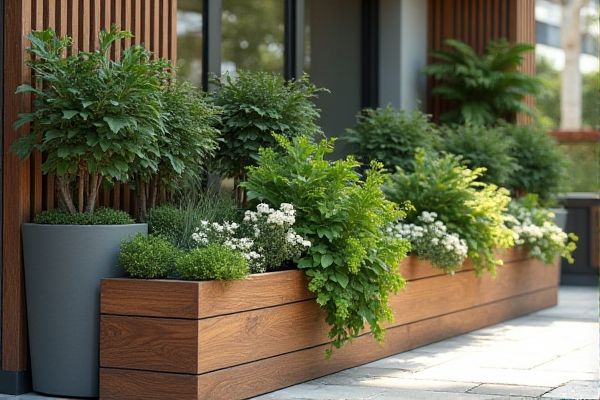
Modular planters offer customizable layouts by connecting multiple units side-by-side, providing flexibility in shaping your garden space, while stackable planters maximize vertical growing area by allowing you to build upwards, perfect for limited floor space. Explore the rest of the article to discover which planter type best suits Your gardening needs and enhances your outdoor or indoor green space.
Table of Comparison
| Feature | Modular Planters | Stackable Planters |
|---|---|---|
| Design | Individual units connected side-by-side | Units stacked vertically |
| Space Efficiency | Good for horizontal space | Optimizes vertical space |
| Flexibility | Customizable arrangement and shapes | Limited to vertical stacking |
| Plants Suitable | Wider variety including large plants | Best for small to medium plants |
| Water Drainage | Independent units reduce overflow risk | Lower units may receive runoff |
| Installation | Simple, snap or slot together | Requires stable base and secure stacking |
| Ideal Use | Balconies, patios, gardens with horizontal space | Small spaces, urban gardening, vertical gardens |
Introduction to Modular and Stackable Planters
Modular planters offer flexible garden design through connectable units that adapt to various spaces, promoting efficient plant organization and personalized arrangements. Stackable planters maximize vertical gardening by allowing multiple planter boxes to be securely piled, ideal for small areas and enhancing greenery without expanding ground footprint. Both styles support innovative urban gardening, with modular planters emphasizing horizontal expansion and stackable planters optimizing vertical space.
Design Concepts: Modular vs Stackable Planters
Modular planters feature interlocking components designed for customizable layouts, enabling flexible garden configurations tailored to space and plant needs. Stackable planters emphasize vertical gardening by allowing pots to be securely piled, maximizing planting area in compact environments. Both design concepts optimize space utilization but cater to different aesthetic preferences and functional requirements in urban gardening.
Space Efficiency and Adaptability
Modular planters offer superior space efficiency by allowing you to arrange individual units in various configurations tailored to your available area, optimizing every inch with customizable layouts. Stackable planters maximize vertical space, ideal for compact environments, but their fixed stacking design limits adaptability compared to modular systems. Your choice depends on whether you prioritize flexible spatial arrangements or height-focused planting solutions.
Material Choices and Durability
Modular planters often utilize high-quality materials like resin, metal, or wood composites that provide enhanced durability and weather resistance, making them ideal for long-term outdoor use. Stackable planters are frequently made from lighter materials such as plastic or biodegradable substances, which prioritize ease of transport and assembly but may compromise longevity under harsh environmental conditions. Choosing between the two depends on the desired balance between structural stability and versatility in material efficiency for garden design.
Assembly and Installation Processes
Modular planters feature individual units that easily connect through built-in grooves, allowing flexible configurations without tools, making assembly straightforward and quick. Stackable planters rely on a secure, vertical interlocking design that requires careful alignment to ensure stability, often necessitating additional hardware or support brackets during installation. Your choice depends on whether you prefer customizable layout options with minimal setup or a compact vertical garden that may involve more precise fastening steps.
Customization Options and Flexibility
Modular planters offer extensive customization options by allowing you to arrange sections in various shapes and sizes to fit unique spaces. Stackable planters provide flexibility through vertical gardening, maximizing limited areas by easily adding or removing layers. Your choice depends on whether you prioritize horizontal versatility or vertical space optimization for your gardening needs.
Suitability for Indoor and Outdoor Use
Modular planters offer flexible configurations that adapt well to both indoor and outdoor environments due to their durable materials and customizable sizes. Stackable planters are ideal for indoor spaces with limited floor area, providing vertical gardening solutions but may require protection from extreme outdoor weather to maintain longevity. Both types enhance space efficiency, but modular planters generally deliver greater resilience for outdoor use.
Maintenance and Plant Care Considerations
Modular planters offer easier access to individual sections, simplifying watering, pruning, and pest control, which helps maintain optimal plant health. Stackable planters can pose challenges with drainage and airflow, requiring careful monitoring to prevent root rot and ensure adequate light distribution. Regular inspection and tailored care routines are essential for both types to support plant growth and longevity.
Cost Comparison and Budgeting
Modular planters generally have a higher initial cost due to their customizable design and durable materials, but they offer long-term savings through versatility and scalability. Stackable planters are often more affordable upfront, making them ideal for tight budgets or small spaces, though they may require replacement or expansion costs as needs grow. Careful budgeting should consider the total investment over time, including potential maintenance and the ability to reconfigure the planter system.
Eco-Friendliness and Sustainability
Modular planters promote eco-friendliness through their customizable design, allowing you to minimize waste by only using the necessary components for your gardening space. Stackable planters often maximize vertical space and reduce the need for additional pots, supporting sustainable practices by conserving materials and reducing plastic usage. Choosing either option helps reduce your environmental footprint by encouraging efficient plant growth with less resource consumption.
 homyna.com
homyna.com